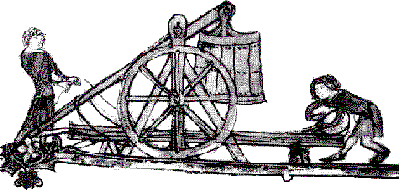
|
(..and what on earth are those people doing in that picture??) |


|
(..and what on earth are those people doing in that picture??) |
| This is definitely not intended to be an in-depth study of the
counter-weight trebuchet (you can find people on the web who can give you
the heavy-duty mathematics.. see the Virtual
Hurling page for some links). Instead, it is a simple look at a few points that would-be trebuchet builders are likely to encounter first. Much of this info is derived from models. Many people will tell you that trebuchets don't scale up from models very well. This is certainly true about some proportions (like the size of the weight bucket), the material strengths and the ranges you can expect to achieve - but the basic mechanics remain the same. |
 |
|---|
 |
|---|
 |
|---|
 |
|---|
|
|
| Last Edited: March 2000 |
|
© Russell Miners 2000. |